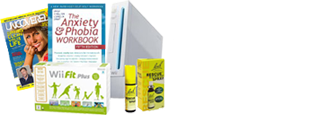
Psychological treatments - fancy a shock!
Last night I caught a segment on The One Show on BBC One, with Ruby Wax on how mental health conditions were once treated, with reference to the old asylums and the treatment of Electroconvulsive therapy.
I had also recently done some reading on this and it has been fascinating to learn about how past treatments compare to modern day talking therapies and I would be very interested to hear other people’s opinion on this.
From the 1930s those who were considered to be “mentally ill” were admitted to lunatic asylums (later replaced by psychiatric hospitals), a place where people suffering with these conditions were brought together and treated collectively in more or less the same way - sometimes brutally using containment and restrain (a very different approach to the client-centred therapy we have today). Being committed to these asylums no doubt produced the incorrect labels of “mad “and “dangerous” and patients were then treated by Electroconvulsive therapy (ECT), where seuzures are electrically induced in anesthetized patients (previously known as electroshock). This was widely used on soldiers returning from war suffering with shell shock. This therapy is still used today but ONLY when no other treatment has been successful.
Since these types of asylums have closed their doors, it is drug medication that has taken the main stance in treating those who are suffering from mental health problems. Anti-depressants are often prescribed by GP’s to alleviate mood disorders such as depression and anxiety. However I recently read a fascinating book called Beating Stress, Anxiety and Depression by Professor Jane Plant, and Janet Stephenson; which details the many side effects of taking such these types of drugs and how with some patients’ had worsened since taking them and now suffer from a catalogue of health problems. Although this is not widely the case in all patients and requires extensive care and attention when taking them.
Which brings me onto talking therapies - counselling, psychotherapy, CBT etc and how these have impacted on the world of mental health treatment as a relatively new method. Now I am not speaking from a wealth of experience but instantly when I am presented with the concept of talking through my problems (or someone talking to me) compared with taking a tablet or having an electric shock – there is no competition – talking to someone and trying to alleviate my problems that way seems like the most attractive treatment?
However I do understand the difficulties and criticisms talking therapies have faced. They are not as measurable in terms of effectiveness as prescriptive medication. Also for the more serious conditions the patients need the best treatment possible and will need to have a range of treatments which will include medication. Also not everyone wants to discuss their problems openly with a stranger, whether they are a professional or not. Also Electroconvulsive therapy and medication was the most appropriate treatment at the time they were introduced and available treatments will continue to change.
A useful point to consider is that there is a range of therapies now available, not only the ones I have previously mentioned here but also music and drama therapy is now becoming popular. It is interesting to see where we are now with treatment of mental health conditions and what a relief it is that asylums have closed their doors and Electroconvulsive therapy has not continued to be a prominent treatment.





Comments
http://www.mentalhealthy.co.uk/news/379-oprah-shocked-that-electroconvul... - This is a link to a report which I did quite a long while ago - if you have not read it already I think it will interest you. Great blog - Liz
Post new comment